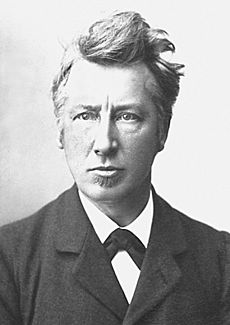Nobel Prize in Chemistry facts for kids
Quick facts for kids Nobel Prize in Chemistry |
||||
|---|---|---|---|---|
 |
||||
| Presented by | Royal Swedish Academy of Sciences | |||
| Location | Stockholm, Sweden | |||
| Reward | 11 million SEK (2024) | |||
| First awarded | 1901 | |||
| Last awarded | 2024 | |||
| Currently held by | David Baker, Demis Hassabis and John M. Jumper (2024) | |||
|
||||
The Nobel Prize in Chemistry is a very important award given each year to scientists who have made amazing discoveries in chemistry. It's one of five special prizes created by Alfred Nobel, a Swedish inventor, in his will back in 1895. These prizes celebrate people who bring the "greatest benefit to mankind" in different areas like chemistry, physics, literature, peace, and medicine.
The Royal Swedish Academy of Sciences decides who wins the Chemistry Prize. They get help from the Nobel Committee for Chemistry, a group of five experts. The award is managed by the Nobel Foundation. Winners receive their awards at a special ceremony in Stockholm, Sweden, every year on December 10. This date marks the anniversary of Alfred Nobel's passing.
The very first Nobel Prize in Chemistry was given in 1901 to Jacobus Henricus van 't Hoff from the Netherlands. He won for his work on how chemicals react and how liquids behave. From 1901 to 2024, 195 people have received this honor. In 2024, the prize went to Demis Hassabis and John Jumper for their work on predicting protein structures. David Baker also won for designing proteins using computers. By 2022, eight women had won the prize. These included Marie Curie (1911) and her daughter Irène Joliot-Curie (1935). Other notable winners were Dorothy Hodgkin (1964) and Ada Yonath (2009).
Contents
Who Was Alfred Nobel?
Alfred Nobel was a Swedish inventor and businessman. He invented dynamite and held many patents. When he passed away in 1896, he left most of his money to create the Nobel Prizes. He wanted his wealth to honor people who made the world a better place.
Nobel wrote his last will in 1895. He set aside a huge amount of money to fund these awards. Because his will was a bit unusual, it took some time for it to be officially approved. Finally, in 1897, the Norwegian Parliament gave its approval. After that, the Nobel Foundation was created to manage Nobel's money and organize the prizes. The Royal Swedish Academy of Sciences was chosen to award the Chemistry Prize.
The Award Ceremony
Celebrating the Winners
Each year, usually in October, the Nobel Committee announces the names of the Chemistry Prize winners. The actual award ceremony is a grand event held on December 10 in Stockholm. The winners receive their prizes from the King of Sweden. After the ceremony, there's a fancy dinner called the Nobel Banquet at Stockholm City Hall.
How Winners Are Chosen
Nomination and Selection Process

Choosing a Nobel Prize winner is a very careful process. First, thousands of scientists, professors, and past Nobel laureates are asked to suggest candidates. These suggestions are kept secret for 50 years! This means we don't know who was nominated until many years later.
The Nobel Committee for Chemistry, made up of five experts from the Royal Swedish Academy of Sciences, reviews all the nominations. They narrow down the list and send it to other experts for their opinions. This detailed review ensures that only the most important discoveries are recognized.
One important rule is that the discoveries must have been "tested by time." This means the committee usually waits about 20 years or more after a discovery is made before giving it a prize. This helps make sure the work is truly groundbreaking and has lasting importance.
Up to three scientists can share the Nobel Prize in Chemistry for their work. They can also be recognized for up to two different discoveries in the same year.
What Winners Receive
Prizes and Awards
Every Nobel Prize winner in Chemistry receives three things: a special gold medal, a unique diploma, and a sum of money.
The Gold Medal
The Nobel Prize medal for Chemistry is identical in design to the Nobel Prize in Physics medal. On the back, it shows the Goddess of Nature coming out of clouds, holding a cornucopia (a symbol of plenty). The Genius of Science is shown lifting a veil from Nature's 'cold and austere face'. The medal has a Latin phrase that means, "It is beneficial to have improved human life through discovered arts." The winner's name is engraved on a plate below the figures.
The Special Diploma
Each Nobel laureate gets a diploma directly from the King of Sweden. These diplomas are truly unique! They are specially designed for each winner by the prize-awarding institution. The diploma includes a picture and text that states the winner's name and explains why they received the prize.
The Award Money
Winners also receive a document stating how much money they have won. The amount can change each year, depending on how much funding the Nobel Foundation has. For example, in 2009, the prize was 10 million Swedish Krona, but in 2012, it was 8 million Swedish Krona. If there are two winners, they usually split the money equally. If there are three, the committee might divide it equally, or give half to one person and a quarter to each of the other two.
See also
 In Spanish: Premio Nobel de Química para niños
In Spanish: Premio Nobel de Química para niños
- List of Nobel laureates in Chemistry
- List of chemistry awards
- List of Nobel laureates
- Nobel laureates by country

